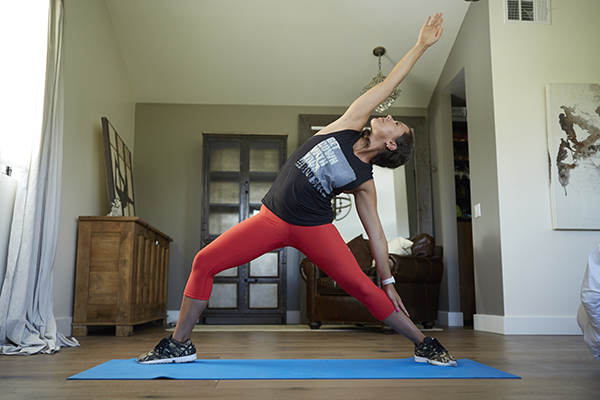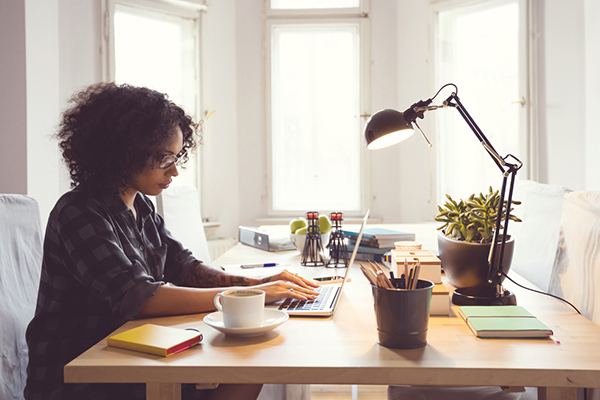How to Stay Healthy While Working From Home

In theory, it’s easier to be healthy when you’re working from home: No office snacks or donuts, you can cook healthy meals, and work out whenever you want.
Win-win-win, right?
The reality, however, probably looks something like this: Slumped on your couch wearing workout clothes you never worked out in (or let’s be honest, your pajamas), tapping away on your laptop, and eating peanut butter out of the jar because you didn’t have the time or energy to make lunch.
Creating a healthy work-life balance is hard enough when you work in an office all day, but it can be just as hard when work and life are happening in the same space.
Find out how you can avoid the pitfalls and maximize the benefits of working from home.
The Benefits of Working From Home
There are undeniable benefits to working from home: the freedom and flexibility of working in familiar surroundings, no co-workers to distract you, being able to wear what you want, time with your pets and/or kids, and the opportunity to knock out some chores, according to Dr. Josh Klapow, clinical psychologist and co-host of “The Web” radio show.
You may not be distracted by co-workers stopping by your desk or people gossiping in the next cube, but there are plenty of opportunities for procrastination.
Think: those household chores, the aforementioned pets (or kids) demanding attention, the lure of Netflix, and the temptation to surf non-work-related websites, to name a few.
Plus, when you’re working from home, it’s easy to skip your workouts, regular meals, social interaction, and even sleep, if you don’t consciously structure your environment to promote healthy habits.
Here’s the good news, though: Staying healthy when you work from home isn’t rocket science.
Follow these 10 practical strategies to help you stay active, eat well, and get your work done.
10 Tips to Stay Healthy While Working From Home
1. Create a designated work area
“Your physical surroundings must be conducive to a work mindset,” says Klapow.
That’s why it’s crucial to avoid sending emails from the sofa and designate an area of your home for business, whether it’s a separate home office, dining room table, or small desk in the corner of a room.
Klapow says a designated work zone accomplishes several things: “It will assure you have your materials readily available, it will [indicate] to others when you are ‘at work’ or not, [and] it will trigger a working mindset,” he explains.
When choosing an area of your home to work in, consider factors like location, lighting, noise level, and physical comfort.
Pick a clean, quiet spot with minimal distractions, then tweak the space to your liking.
Make sure your chair is comfortable, turn your desk to face the window, organize your work materials, display framed photos, and add some greenery.
Research shows that even adding a couple of plants to your workspace can help soothe you and lower your stress levels.
2. Schedule your day
It’s critical to create a structure for your day; even a loose outline can help you stay on task and prioritize your workload.
First and foremost, set clear start and finish times for your workday, advises Klapow.
“Your at-home workday may be shorter or longer than a workplace workday, but it [still] needs to have its own set schedule,” he says.
That includes scheduling a lunch break and time for meetings and phone calls, plus realistic but adjustable windows of time to accomplish the most important items on your to-do list.
When creating your schedule, consider the time of day you feel most energized and alert, as well as the time of day you feel most sluggish or prone to distraction, then organize your tasks and breaks accordingly.

3. Prep meals and snacks
“Nutrition is very important to staying focused, energized, and productive throughout the day,” says Jennifer Glockner, R.D.N. and creator of Smartee Plate. “It’s hard to concentrate and be productive when you’re hungry or your blood sugar is low,” she explains.
Much like eating healthy at the office, Glockner says the key to eating nutritious foods at home is to stock your kitchen with healthy foods and meal prep.
“Limit sugary drinks and foods, such as refined carbs (for example, white bread and baked goods), that will give you a quick energy boost, followed by an insulin spike and consequent low blood sugar in about two to three hours,” she explains. “This can lead to a lack of concentration and feeling jittery, sweaty, or hungry.”
Instead, stock your fridge and pantry with fruits and veggies, whole grains, and lean proteins.
To minimize temptation and prevent overeating — or munching on cereal for lunch — Glockner recommends planning your meals ahead of time and pre-portioning healthy snacks.
“Snack on an orange with a handful of nuts, plain yogurt with berries, hard-boiled egg with a tomato, or hummus with a whole grain cracker or red pepper strips,” she says.
Pro tip: For more tasty snack ideas, check out these 9 healthy, high-protein snacks.

4. Schedule a workout into your calendar
It’s easy to skip workouts when you’re hustling from home, but making time for a solid sweat session has myriad mental and physical health benefits.
Aside from improving your overall fitness, research shows that regular workouts can also help lower your stress levels and increase your energy, which in turn, can help you stay focused and disciplined.
The key to making a workout happen at home is to put it on your calendar, the same way you would schedule a work meeting. “Don’t assume that because you are home you will just work out,” Klapow cautions.
Slot your workout for the early morning before or after work hours, or add it somewhere in the middle of the day when you start to feel antsy — and with a streaming workout service like Beachbody On Demand, you can crush a workout without leaving the house.
5. Relax… within reason
Working from home means you have the luxury of taking an occasional break without having to keep an eye for your boss.
If you’re not careful, though, a well-intentioned mini-break can easily turn into a Netflix marathon or hours-long nap.
If you need a break, “relax but don’t nap,” Klapow advises.
Instead, do something calming that won’t cause you to doze off: Cook a healthy meal, free-write or draw in a notebook, take a brisk walk, or do some yoga.
6. Sit down to eat
It’s normal to plow through your workday without stopping to refuel, but according to Glockner, scheduling time for breakfast, lunch, and dinner can actually help facilitate your productivity.
Why? Because “skipping meals may lead to fatigue and consequent lack of concentration,” she explains.
Not only that, but eating a full meal can help prevent you from mindlessly grazing throughout the day, Glockner says, “which is especially important due to easy access to the kitchen at home.”
While you do sit down to a meal (at your kitchen table, not your work desk!), shut down your electronic devices and practice mindful eating: Take small bites, chew your food thoroughly, and notice the flavors and texture in each mouthful.
7. Get out of the house
Make a point to leave the house — without your car — at least once a day.
Bike to meet a friend for lunch, take your dog or kids to hang out at the park, or replace a coffee break in your kitchen with a walk to the nearest coffee shop.
By getting out of the house, you’ll get some much-needed social interaction, and enjoy some new scenery — in fact, a quick walk may even help boost your creativity.
Pro tip: Need more ideas on how to move more? Here are 14 unique ways to get your 10,000 steps in.
8. Drink plenty of water
Make sure you stay hydrated throughout the day, Glockner says. “Dehydration may lead to fatigue and headaches, which may compromise [your] alertness and productivity,” she explains.
Aim to drink half your body weight (in pounds) in ounces of water each day.
If you’re struggling, here are 25 simple ways to drink more water.
9. Take mindfulness breaks
“Every hour or so, get up, take a deep breath, and be mindful of your comfortable surroundings,” Klapow advises. “Take in the fact that you may have your dog by your side or a fish tank behind you. Peek outside and look at the flowers,” he says.
Pausing to notice these small joys is like a quick dose of meditation.
“This will not only give your mind a break, it will help you feel more optimistic,” Klapow explains.
10. Develop a shutdown ritual
In a traditional office setting, you know it’s the end of the workday when you pack up your things and head home.
But when you’re already home, the line between work and “home” time can blur. “You cannot allow your workday to simply bleed into your before and after work schedule just because you are at home,” Klapow explains.
That’s why it’s helpful to develop a routine that simultaneously signals the end of the workday and helps you transition away from emails and work projects.
Your shutdown ritual can be as simple as closing your laptop and storing it out of sight, or doing something more involved, like a workout or leaving the house for a stroll or errands.
The 10-Second Takeaway
Don’t let the comfort and familiarity of home get in the way of your work productivity or your health.
By organizing and scheduling your work and home tasks, and creating physical and mental boundaries, you can establish a healthy balance that will make your boss and your body happy.

